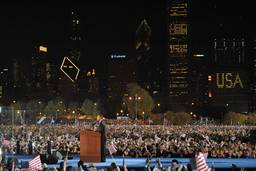We live in a communications desert. How can this be, you, say? Our 24/7 news cycle delivers information by the millisecond to our living rooms, ears, laptops and cell phones. Every day, Americans are barraged with millions of words, bytes, video clips, posts, emails and tweets via thousands of newspapers and digital channels.
Yes, we are drowning in a blog-YouTube-Google-Facebook-fueled world. Yet paradoxically, in this “revolutionary” media age, our cities are parched for information and news coverage with context and quality. From mainstream news organizations to Internet upstarts, too many in the media traffic in stale conventional wisdom, stereotypes and misinformation about the lives and aspirations of those who live on the margins.
On April 9, at the National Conference for Media Reform in Boston, a panel of Chicago-based In These Times journalists (including myself; details in sidebar) will dissect the state of journalism in urban centers. Understanding cities’ media environment is urgently needed, given new research supported by a consortium of national and local foundations. Community News Matters, an initiative launched in August 2009 by the Chicago Community Trust and other Chicago foundations*, aims to assess the news needs of low-income and minority communities on the Chicago’s South and West sides.
I’m glad someone is finally asking.
An 800-person phone survey conducted as part of the initiative revealed that low-income respondents in the Chicago area were less connected on every measure tested: attending community events, volunteering, registering to vote and voting. For example, 69.4 percent of low-income respondents said they voted in last election; 85.7 percent of others did. And half of low-income residents said they felt informed enough about issues relating to their job or profession, compared to 68.1 percent of others.
Community News Matters is being watched by media-makers and activists around the nation. On April 4, the Trust announced 31 Local Reporting Awards to writers, citizen journalists and nonprofits to produce innovative reporting and analysis of issues affecting minority and low-income neighborhoods. (In These Times received one of these awards to fund a series of features by Salim Muwakkil, who will be one of the panelists at the media reform conference.)
“High-quality journalism and analysis is vital to public discourse,” says Ngoan Le, vice president of program for the Chicago Community Trust. “We hope this burst of reporting will ensure that the needs and perspectives of the city’s poorest communities are heard and understood at this critical time.” (Full disclosure: I served on the grant selection committee).
A South Side community organizer told researchers she lives in a “communications desert.” Vital information does not reach her neighborhood. “We keep talking about the bad stuff,” she said. “We don’t talk about what’s good that’s going on out in the communities.”
People thirst for news they can use – and trust.
Community News Matters focus group participants said they read Chicago’s dailies, but find little in the newsprint that resonates with their lives. Newspapers are losing boatloads of readers because their stories have lost relevance. A West Side healthcare activist wistfully recalled the good old days. “I remember, even maybe 25 years ago, you would see the newspaper stands and you would see all kinds of folks – even the folks with the bottle in the back pocket – going and getting a paper,” she said. “You see them going through the paper, and they hang on to the paper.”
And now? “Who wants to pick up something every day [that’s] talking about another child got shot 22 times? she exclaimed. “Or all the kids are dropping out of school?”
The days when a white-haired Cronkitean television news anchor could reassure a general viewership are gone forever. If the network-owned television outlets want to know why their coveted ratings are sliding, they should ask this crowd. Most respondents scorned television news as superficial, celebrity-driven and bloody. “The news got so bad…that I turned off the news,” said one grandmother. “It was upsetting me because of all the violence and everything.”
Another said she cannot watch the late night news because it gives her nightmares.
Ouch. The feedback pains this writer. I have edited and reported for decades in newspapers, TV, radio and alternative media. Chicago newsrooms still enjoy a plethora of talented and caring journalists who doggedly fight for meaty advocacy and watchdog reporting. Big city newspapers still reach decision-makers and set agendas. Yet they are stymied by dwindling resources, a corporate mentality and obsolete business models.
Of course, the Internet continues to explode with information, but the options are so overwhelming, many people simply opt out.
So where do Chicagoans turn for news and information in this communications desert? There are some oases among the tumbleweeds. Focus group participants singled out niche outlets like the Chicago Reader and offerings from black-owned WVON radio and the Chicago Defender. Spanish TV and radio were also go-to news sources, along with Chicago Public Radio and cable access shows (CAN-TV). My pick: The Chicago affiliate of ABC-TV, where I currently work, which produces fine reporting on neighborhood issues and contributes to community causes.
Chicago’s news consumers are no different from those in Detroit, Atlanta or Los Angeles. They want local, accessible news: more community newspapers, church newsletters and bulletins. People are scrambling in these hard times of economic depression, rampant budget deficits and pernicious crime. They need hands-on data about jobs, education, public safety and healthcare.
For me, the thorniest question is buried deep beneath the desert floor. Chicago, a majority-minority city, is the stomping grounds of America’s first black president. Pundits chatter that the Age of Obama has ushered us into a post-racial society. Really? The gnarly racial stereotypes and barriers are still with us, and reflected in our media coverage. When reporters come looking for people battling the foreclosure crisis, they want “that nice, clean white family,” a community organizer told a focus group. “Because it’s perceived if you’re poor, if you’re Hispanic – you’re illegal, first of all. If you’re black…it was your fault.”
Little wonder. In urban America, most news decision-makers are still white males with scant ties to or knowledge of the people they purport to cover. Reporters parachute into black and Latino neighborhoods to cover violent crime and community conflict. They are quick to interview the vagrant on the corner with the rag on his head, but not so much the hardworking neighborhood entrepreneur.
In the focus groups, it was the people of color, not whites, who talked most openly about race. That’s understandable. Race and racism are messy, and there are no facile answers. Yet every urban challenge and issue comes back to race.
So what seeds should we plant in the communications desert?
Elevate Race. Find information sources that can broker honest conversations about race and racism. Expose racial barriers and develop strategies to knock them down.
Up With Hope. Support news coverage and information that emphasizes solutions instead of the failures.
Collaborate. Partner with the news media who value community stories that unify people in common causes, rather divide them through fear.
Go Local. Develop and support both digital and traditional information models that are created by and for people of color, from the neighborhood shopper to the church bulletin to the community blog.
Go Viral: Encourage the use of social media in grassroots organizing campaigns.
These are broad but crucial starting points – surefire ways to transform our sadly barren urban media landscape into a blossoming garden.
*The Community News Matters project is funded by The Chicago Community Trust, the John S. and James L. Knight Foundation, the John D. and Catherine T. MacArthur Foundation, the McCormick Foundation, the Richard H. Driehaus Foundation and the Woods Fund of Chicago.








